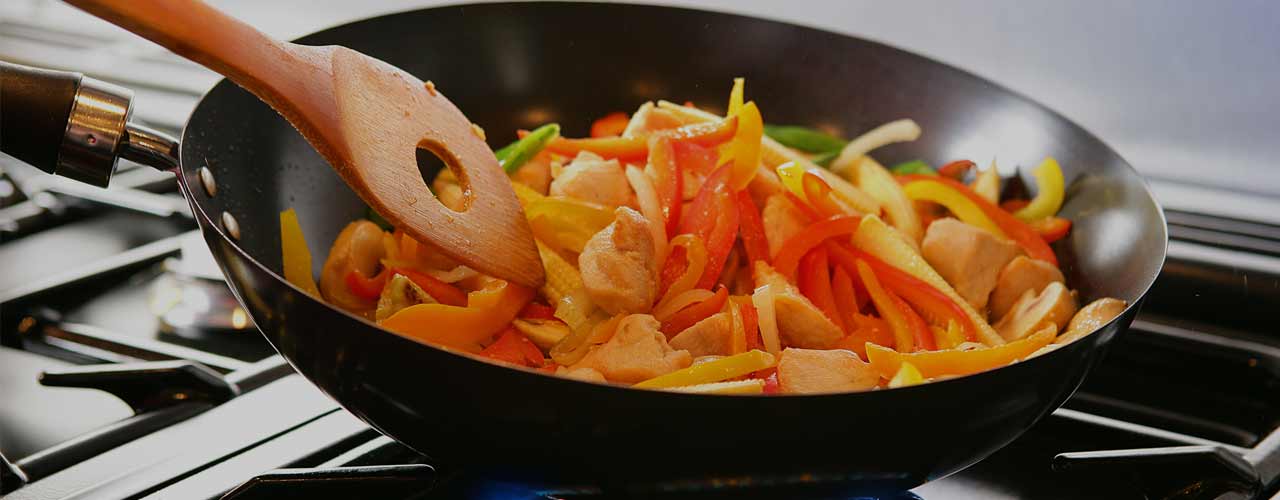
After choosing the type of wok that works best for you, it's time to determine if your pan needs to be seasoned. Woks that are made of porous metals like cast iron and carbon steel must be seasoned before cooking to prevent rust. This article will provide you with detailed instructions for cleaning, seasoning, and caring for your new cookware.
Shop All WoksHow to Season a Wok Video
If you're looking for a visual guide on how to clean and season a wok, check out our video below.
How to Season a Wok
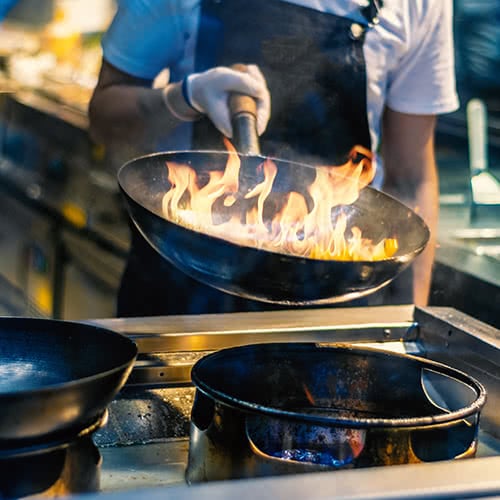
Every chef has his or her own favorite method for seasoning their pans. We'll explore three of the most popular methods: stovetop seasoning, oven seasoning, and salt seasoning. Regardless of the method you use to season your wok, the first step is always to wash the wok so the bare metal is exposed.
How to Season a Wok on a Stovetop
The stovetop method is a popular way to season your wok. You'll need a range top burner, the oil of your choice, and paper towels.
- Complete initial washing to remove factory oil.
- If your wok has wood handles, wrap them in aluminum foil to prevent scorching/burning, or remove them.
- Preheat the wok over high heat to open the metal's pores. The wok will get very hot and release smoke, so make sure the space around your burner is clear, your kitchen hood fan is on, and your windows are open.
- Tilt and flip your wok to heat the front, back, and sides. Your wok will change colors when exposed to the heat.
- Perform a water test by throwing a drop of water on the pan. If your wok is hot enough, the water will evaporate within a second, and it’s ready to be seasoned.
- Allow the wok to cool until it is safe to touch.
- Use a paper towel to coat your wok in a high smoke point oil. Try to keep the oil layer thin and even to achieve a smooth, nonstick surface. Because the seasoning also acts as a rust protectant, make sure you coat the outside of your wok in oil as well.
- Return your wok to the burner over medium-high heat. Once the oil stops smoking, that portion of the wok is seasoned. Proceed to flip and tilt the wok to season each section.
- Your wok seasoning process is complete when the entirety of its surface has changed to a matte finish and dark hue.
- Rinse your wok with hot water and use a bamboo wok brush to clean the wok without removing your seasoning.
- Place the wok back onto your stovetop over high heat to evaporate the remaining water particles.
- Either store the wok until you’re ready to use it or repeat the seasoning process. Season the wok up to three times to achieve a slicker nonstick surface and a thicker protective coating.
How to Season a Wok in the Oven
This method is recommended for woks with oven safe handles.
- Complete the initial washing to remove factory oil.
- Preheat the oven to 450 degrees Fahrenheit.
- Line a sheet pan with aluminum foil.
- Use a paper towel to coat the entire wok with lard, shortening or oil, including the outside of the pan.
- Place the lined sheet pan on the bottom rack of your oven.
- Place the oiled wok on the top rack.
- Bake for 20 minutes and remove the pan from the oven.
- Rinse the wok with warm water and a soft sponge.
- Dry it completely on the stovetop over high heat.
How to Season a Wok with Salt
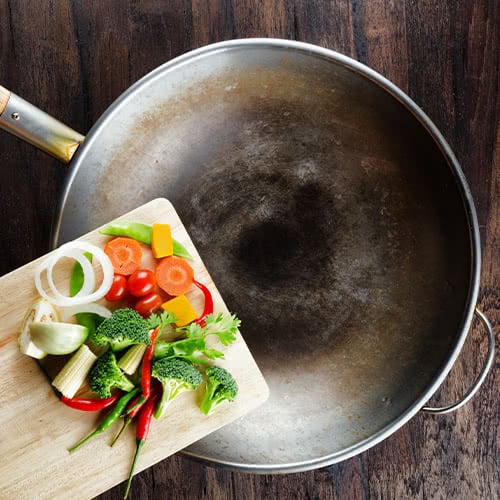
This method uses kosher salt to develop a dark patina on your wok. It can also be used to refresh or re-season a pan that hasn't been used in a long time.
- Complete the initial washing to remove factory oil.
- Pour 1 cup of kosher salt into a wok.
- Place wok, filled with salt, on a gas stovetop over high heat.
- Stir salt constantly for 20 minutes, pushing the salt up and around the sides of the wok.
- After 20 minutes, remove the wok from heat and dump the heated salt into the sink (letting it cool before you discard it).
- Wipe the wok clean with an oil-covered rag or paper towel, spreading a thin layer of oil onto the wok’s surface.
Why Season a Wok?
Seasoning your cast iron or carbon steel wok creates a patina. A seasoned wok will help infuse flavors into the dishes cooked inside, as well as provide a smooth non-stick surface. Without first seasoning your wok, any foods cooked inside will likely stick and won't have lots of flavor.
What Is a Patina?
A patina is a protective coating inside of the wok. The coating helps prevent corrosion and rust, while simultaneously enhancing the flavor of the food cooked in your wok. Every time you cook with oil in your wok, the patina becomes thicker and heavier, creating a natural, non-stick cooking surface.Tips for Preserving Your Wok's Seasoning
- Cook, saute, and fry often to continuously build a patina
- Invest in a bamboo wok brush, wok ladle, and wok spatula
- Don’t steam, boil, or poach products in your new wok
- Avoid cooking with acidic products in a newly seasoned wok, including tomatoes, vinegar, and lemon
- Don’t use abrasive pads or any warewashing chemicals, including soaps and sanitizers
How to Clean a Wok
When you purchase a new wok, it's important to clean it before you do anything else. Manufacturers apply factory oil to new woks to protect them from humidity during shipping. This prevents rust and ensures the wok arrives in pristine condition.
To prepare your new wok for seasoning, you need to give it a good scrub with a sponge and soap to remove all the factory oil and any dust that has collected in the pan during shipping. This will be the only time you need to use soap and an abrasive sponge to clean your pan. Follow the steps below to remove all residue:
- Fill a sink with hot, soapy water.
- Scrub the inside and outside of wok with a scouring pad.
- Rinse the wok completely.
- Dry wok with a clean, dry towel.
- Place on a stovetop over medium-high heat to completely dry the wok and evaporate any leftover water.
How to Clean a Wok After Use
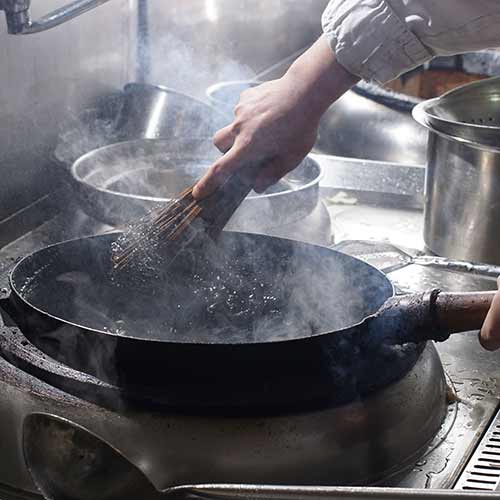
Always refer to the care instructions that came with your wok. Typically, aluminum, stainless steel, or copper woks can be placed in the dishwasher. Cast iron or carbon steel woks require special care so that the seasoning isn't removed during cleaning. To clean your wok after cooking, follow these easy steps:
- Rinse wok in warm or hot water.
- If you need to sanitize it for specific regulations, you can briefly submerge it in pure boiling water, free of soap and chemicals.
- If food particles need to be removed, gently scrub with a sponge or wok brush.
- Do not use abrasive scouring pads, soaps, sanitizers, or warewashing chemicals as they will remove the seasoned surface you just created.
- Rinse off any loosened debris.
- Dry completely with a towel.
- Place the wok over medium-high heat to finish drying and evaporating any remaining water.
- If you’re planning to store your wok without using it for over a week, we suggest applying an additional thin layer of oil or lard to further preserve the wok’s patina.
How to Clean a Wok with Rust
If your wok has rusted, you must first soak it in warm water for 5-10 minutes to make rust removal easier. After soaking, the rust should come off, allowing you to clean your wok normally. For tough-to-remove rust, you can use steel wool to scrub your wok clean. However, removing rust with steel wool or other abrasives will remove your wok's patina, so be sure to season your wok again.
Best Oil for Wok
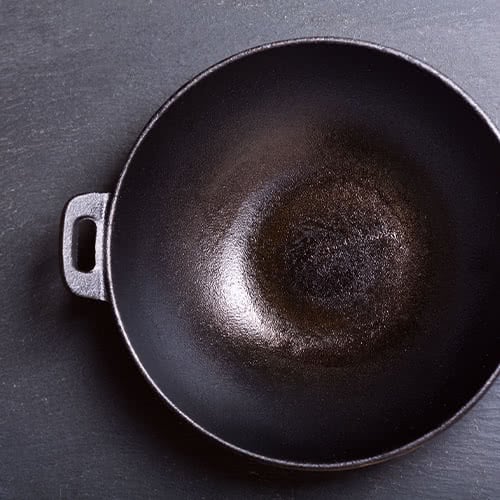
The best oils to use with a wok have a high smoking point, which means they can be used at high temperatures without burning. They should also be refined and impart a neutral flavor. Avoid unrefined oils with low smoking points like olive oil and sesame oil. Choose one of these oils for seasoning your wok instead:
- Peanut oil
- Canola oil
- Grape seed oil
- Sunflower oil
- Lard or pork fat
- Shortening
Every time you use your wok, the patina will become more developed and the pan's performance will improve. Its non-stick properties will increase and food will release quickly and easily from the pan. Cleaning will become easier too, as food particles are less likely to stick. With the proper care, your wok will last you for many years to come.






